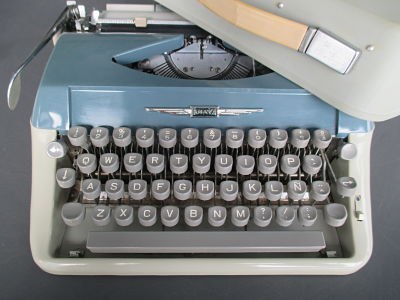Amaya Typewriter

In the 19th century, office work was already widespread. However, all of the documents were still written by hand, making the work very slow. Although at that time several attempts were made to develop an automatic form of writing, typewriters weren't commercialised until the 1870s. The first company to do so was the famous North American brand, Remington.
Around 1920, typewriters overcame the initial difficulties and a standard design was achieved. Despite the differences from one model to another, almost all machines used the following mechanism: each key was connected to a type hammer with the corresponding character in relief on its opposite end. On pressing a key, the type hammer would strike an inked ribbon stretched in front of a cylinder which held the paper in place and moved forwards and backwards. This is how the letters were typed onto the paper.
As far as Spain is concerned, typewriters arrived in the 1920s, reaching their moment of greatest fame in the ‘70s. Despite the most famous brand being Hispano-Olivetti, a number were also made in Eibar: for example, the company Imperial Española S.A. located in the Calle Bilbao produced the Patria model, released in 1947. This model, inspired by another Swiss machine, was given the name of Amaya in time. This is the origin of the piece of the month.
This typewriter arrived at the museum in 2009 thanks to a donation by Mateo Guilabert Lopetegi, and is in exceptionally good condition. Being portable, it comes in its plastic case with a handle on the top for carrying. The machine itself is made in metal and plastic, grey with blue details. On the front you can read the brand name, with two wings on the sides. The keyboard has numbers and symbols.
As an anecdote, on the left of the keyboard the machine has a lever for choosing the ribbon colour (blue or red). Thanks to a patent for the invention in 1960, we know that this lever was invented by Pedro de Arieta-Arunabeña y Ruiz, and that for at least 20 years Imperial Española S.A. had permission to use it. It would seem that prior to this invention the lever for changing colour was situated very close to the carriage shift, complicating its use. Thanks to the new location, changing colour became faster and easier. Also, thanks to this detail we can say in complete certainty that the piece we have at the Museum dates from the ‘60s or ‘70s, and that it is not therefore the first Amaya model produced by the brand.
In today’s world, where we are up to our ears in computers, it's not such a bad idea to cast our eyes back every now and again to remember how things were not so long ago.

